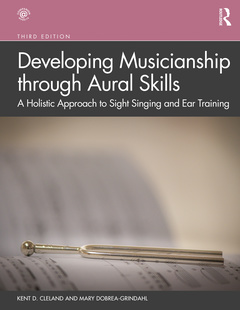Developing Musicianship through Aural Skills (3rd Ed.) A Holistic Approach to Sight Singing and Ear Training
Auteurs : Cleland Kent D., Dobrea-Grindahl Mary

Developing Musicianship through Aural Skills, Third Edition, is a comprehensive method for learning to hear, sing, understand, and use the foundations of music as part of an integrated curriculum, incorporating both sight singing and ear training in one volume. Under the umbrella of musicianship, this textbook guides students to "hear what they see, and see what they hear," with a trained, discerning ear on both a musical and an aesthetic level.
Key features of this new edition include:
- Revised selection of musical examples, with added new examples including more excerpts from the literature, more part music, and examples at a wider range of levels, from easy to challenging
- New instructional material on dictation, phrase structure, hearing cadences, and reading lead sheets and Nashville number charts
- An updated website that now includes a comprehensive Teacher?s Guide with sample lesson plans, supplemental assignments, and test banks; instructional videos; and enhanced dictation exercises.
The text reinforces both musicianship and theory in a systematic method, and its holistic approach provides students the skills necessary to incorporate professionalism, creativity, confidence, and performance preparation in their music education. Over 1,600 musical examples represent a wide range of musical styles and genres, including classical, jazz, musical theatre, popular, and folk music. The third edition of Developing Musicianship through Aural Skills provides a strong foundation for undergraduate music students and answers the need for combining skills in a more holistic, integrated music theory core.
Preface
The Method
Syllable Systems
Reading in Clefs
Module 1: Simple Meters
Module 1a: Simple Beats and Their First Division and Multiple Note Values
Module 1b: Simple Duple and Quadruple Meters
Module 1c: Simple Triple Meters
Module 1d: Second Division and Multiple of the Beat in Simple Meters
Module 1e: Rests
Module 1f: Ties and Dotted Rhythms in Simple Meters
Module 1g: The Anacrusis
Module 1h: Less Common Simple Meters
Module 2: Major and Minor Scales and Scale Degrees
Module 2a: Major Scales and Scale Degrees
Module 2b: Minor Scales and Scale Degrees
Module 3: Improvisation
Module 3a: Introduction to Improvisation
Module 3b: Methods for Improvisation and Improvising Tonic Function
Module 3c: Improvising Dominant Function
Module 3d: Improvising Predominant Function
Module 3e: Improvisation Through Arpeggiation
Module 4: Compound Meters
Module 4a: Compound Beats and Their First Division and Multiple Note Values
Module 4b: Second Division of the Beat in Compound Meter
Module 4c: Less Common Compound Meters
Module 5: Intervals
Module 5a: Hearing and Singing Intervals Acontextually
Module 5b: Major and Minor Seconds
Module 5c: Major and Minor Thirds
Module 5d: Perfect Fifths and Octaves
Module 5e: Perfect Fourths
Module 5f: Minor and Major Sixths
Module 5g: Tritones
Module 5h: Minor and Major Sevenths
Module 6: Triads
Module 6a: Hearing and Singing Acontextual Triads
Module 6b: Root Position Major Triads
Module 6c: Root Position Minor Triads
Module 6d: Inverted Major and Minor Triads
Module 6e: Diminished Triads
Module 7: Seventh Chords
Module 7a: Singing and Hearing Seventh Chords Acontextually
Module 7b: Dominant Seventh Chords in Root Position
Module 7c: Dominant Seventh Chords in Inversion
Module 7d: Minor Seventh Chords
Module 7e: Half-Diminished Seventh Chords
Module 7f: Fully-Diminished Seventh Chords
Module 7g: Major Seventh Chords
Module 8: Common Diatonic Harmonic Progressions
Module 8a: Cadences and Phrasing
Module 8b: The TPDT Progression
Module 8c: Circle of Fifths Progressions
Module 8d: Filled-In Descending Thirds (Pachelbel) Progressions
Module 8e: Ascending Sequential Progressions
Module 9: Irregular Division and Syncopation
Module 9a: Triplets
Module 9b: Duplets
Module 9c: Syncopation Within a Measure (Intra-measure Syncopation)
Module 9d: Syncopation Across a Barline (Inter-measure Syncopation)
Module 9e: Triplets in Augmentation and Diminution
Module 9f: Other Divisions of the Beat
Module 9g: Reading Complex Rhythms
Module 10: Non-modulating Chromaticism
Module 10a: The Chromatic Scale and Surface Chromaticism
Module 10b: Modal Mixture
Module 10c: Secondary Chords in the Major Mode
Module 10d: Secondary Chords in the Minor Mode
Module 10e: Neapolitan and Augmented Sixth Chords
Module 10f: Extended, Added Note, and Altered Chords
Module 11: Modulation
Module 11a: Techniques for Modulation
Module 11b: Modulation Between Relative Keys
Module 11c: Modulation to the Dominant
Module 11d: Modulation to Other Closely Related Keys
Module 11e: Modulation to Distantly Related Keys
Module 12: Changing Meter, Polyrhythm, and Asymmetric Meters
Module 12a: Changing Meter
Module 12b: Metric Modulation
Module 12c: Polyrhythms and Polymeters
Module 12d: Meters with Unequal Beats
Module 13: Other Tonally Derived Scales
Module 13a: Pentatonic and Blues Scales
Module 13b: The Ecclesiastic Modes
Module 13c: Synthetic Scales
Module 13d: Polytonality and Polymodality
Module 14: Post-tonal Music
Module 14a: Whole Tone and Octatonic Scales
Module 14b: Post-tonal Music
Appendices
Appendix A Glossary of Non-English Musical Terms
Appendix B Using Your Voice: Suggestions for Vocal Production for Non-singers
Index of Literature Examples
Credits
Kent D. Cleland is Professor of Music Theory at the Baldwin Wallace Conservatory of Music, where he has taught music theory and aural skills since 1999.
Mary Dobrea-Grindahl is Professor of Piano and Chair of the Department of Keyboard Studies at the Baldwin Wallace Conservatory of Music, where she teaches solfège, Eurhythmics, and private piano.
Date de parution : 09-2020
21x28 cm
Date de parution : 08-2020
21x28 cm
Thème de Developing Musicianship through Aural Skills :
Mots-clés :
Ear Training; aural skills; Holistic Approach; aural training; Scale Degree; musicianship; Trio; Follow; sight singing; Empty Measures; music theory; Seventh Chords; Lead Sheets; Blank Measures; Simple Triple Meter; Simple Quadruple Meter; Compound Meters; Simple Duple Meter; Chord Symbol; Dominant Seventh Chord; Consequent Phrase; Scale Degree Pattern; Minor Mode; Unique Sound; Jazz; Tonal Center; Component Scale Degrees; Leading Tone Triads; Minor Scale; Simple Meters



